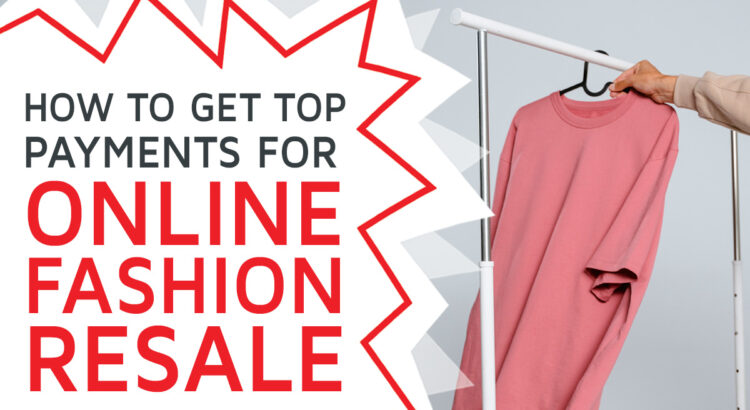Selling secondhand fashion online is as old as the web itself.
We could argue that eBay was the first successful online marketplace to exist. 25 years later, pre-owned clothing is all the rage again with buyers and sellers. With new verve, fashion retailers have pushed into the resale market. A market which is projected to become a very lucrative one.
Brands like Dior, Chanel and Gucci have already adopted the practice of so-called branded resale. Many of their competitors are following suit. Some companies have run their online recommerce programs for a while now. A survey by statista proves them right: When it comes to digital features by luxury brands, customers look forward to resale programs above all else. For regular-income customers, the market is also in full swing. Fashion businesses in the mid-price segment have started resale programs, too. This includes those often labeled fast fashion. H&M, Shein and Zara are well on board. Even sports apparel brands adopt the practice – think Lululemon, Adidas, Nike or Decathlon.
But moving from e-commerce to recommerce comes with challenges for businesses – many of which relate to payment. This article will provide insights into the matter, discussing:
- The reasons why fashion companies should enter the resale market
- The differences between branded resale platforms and secondhand P2P marketplaces
- The downsides of using a third-party payment system on a fashion resale platform
- The payment challenges fashion resale companies face
The Benefits of Recommerce for Fashion Brands
The secondhand market is popular with customers, making it a highly lucrative opportunity for fashion brands. Offering resale products will ultimately benefit those brands in various ways, e.g. by allowing them to:
- Access a new, increasing source of revenue: According to Global Data, the global market value of fashion recommerce is estimated at over $US 182 billion for 2022. By 2026, experts expect the market to have grown an additional 16%. As ThredUp pointed out in 2022, resale already is growing three times as fast as conventional apparel.
- Improve their sustainability profile: Refurbishing and reselling fashion consumes fewer resources than producing more of it. Moving towards upcycling older items marks a step away from so-called fast fashion towards so-called circularity services. All of this will give eco-conscious customers a good feeling.
- Reduce overproduction to fit customer expectations: We see an increased sensibility for waste and overproduction among customers. Above all, younger demographics like Millenials and Gen Z want clothing to have a longer lifespan. Through 2027, secondhand revenue growth generated from the Millennial generation will rise by 33%, according to ThreadUp. From Gen Z, it’s 28%. What’s more, by producing less, companies can reduce production costs. And all that while still catering to the current resale market size.
- Reaccess out-of-sale products: Customers can get access to older or even vintage fashion items. At the same time, companies make sure that old favorites are remembered. They also can check the demand for an eventual reboot of a line.
- Strengthen existing customer/brand relationships: Fashion companies can encourage customers to sell old products in so-called buyback programs. The result is that customers interact with the brand more often and to mutual benefit.
- Turn returns into a source of revenue: Items that fashion retailers would otherwise dispose of can yield new profits.
- Retain financially strained customers: As the costs of living escalate, customers in many countries spend less. Fashion retailers can counteract this by selling used fashion at reduced prices. Also, they can run buyback programs and peer-to-peer marketplaces for customers to sell their old items. This keeps buyers who had a previous relationship with the brand closeby, as they can still afford its products. Retailers could enhance their buyback offers by not only presenting customers with a competitive selling price, but also by offering additional incentives such as discounts on new purchases or loyalty points.
By 2030, the U.S. online recommerce market is projected to surpass the offline market by $US 37.5 billion in revenue.
Source: Statista, 2020
Peer-to-Peer Marketplaces vs. Branded Resale Platforms
Many companies already resell items they receive from returns at a discount – a revenue-impacting challenge in fashion retail. Yet, running an in-house B2C resale program goes one step beyond selling returned goods. A typical recommerce sales process entails:
- Obtaining pre-owned items from former customers via buyback platforms and initiatives
- Assessing those items for authenticity and damages, often done by professionals
- Refurbishing the items for a new sale
- Presenting the items on a shopping platform, with the proper name, search tags and pictures
- Processing a purchase of the items like any regular sale
There are alternatives to this intricate process. Fashion brands can leave the selling and shipping of pre-owned merchandise to their customers. To do so, the brand could run a platform for peer-to-peer resale.
Some brands also collaborate with fashion resale service providers for logistics and infrastructure support. This collaboration gives rise to exclusive, company-branded marketplaces that operate as a service. SaaS companies like Archive or Recurate are prime examples of resale marketplace providers, running B2C resale programs for multiple brands.
Ultimately, it’s a strategic decision on which approach (P2P or B2C, an own plattform or run by a third-party provider) a business chooses to follow. Let’s have a look at different approaches.
P2P Second Hand Marketplaces
Peer-to-peer (P2P) marketplaces have been very popular with customers since the heyday of eBay. P2P platforms’ success lies in their ability to allow any buyer to become a seller. They are also convenient for their customers due to their typically easy onboarding process.
Almost 2 in 3 fashion retailers providing resale state they will increase their investments in it within the next 2 years.
Source: ThredUp, 2023
The number of successful multi-brand portals for pre-owned fashion has risen sharply over the past decade. Examples include:
- Bazaara
- Carousell
- Depop
- Poshmark
- Vinted
- etc.
The listed platforms allow customers to sell everything their wardrobe holds. For fashion companies, that means that their products are presented besides similar products by rivals across all price categories. In such shopping environments, brands have difficulties displaying their products in the right light.
In reaction to that, companies have started to establish their own branded P2P marketplaces. It’s fast fashion providers who follow this approach in particular such as H&M, Shein or Zara. However, there are also companies leaning more toward luxury fashion that became active here, like Et Tigre or Juicy Couture.
Ultimately, many customers favor peer-to-peer marketplaces over B2C. Those platforms successfully attract them with easy onboarding, smooth customer journeys, mobile-first interfaces and social community features. Fashion brands can leverage this popularity with their own branded P2P shops.
39% of customers prefer peer-to-peer platforms compared to 24% who favor consignment shops.
Source: Morning Consult Pro, 2022
What’s more, fashion brands could outsource fulfillment to private sellers. This saves them packaging, shipping and warehousing, as well as trouble with returns and refunds or chargeback disputes.
B2C Branded Resale Shops
The alternative to peer-to-peer marketplaces would be a B2C platform. Fashion companies utilizing this model can operate their own secondhand branded resale shop. Alternatively, they can partner up with multi-brand platforms to present their own brand shop on those platforms.
For instance, Gucci and Jimmy Choo have joined up with the multi-brand platform Vestiaire Collective to run a shop for pre-owned items. Levi’s on the other hand runs its very own secondhand online shop.
As of now P2P fashion resale platforms are more popular than B2C platforms. Only slightly so, however, as over one-third of customers don’t have any preferences in one or the other direction.
Putting emphasis on originality, high fashion brands will find the B2C model better suited for them. In P2P, brands have no control over quality and authenticity – customers just take the clothes out of their drawers and sell them in whatever condition they are. In a branded marketplace, the company handles the secondhand sales in-house. The company gets the items from customers before selling them on the platform. This provides ample opportunity to check them for authenticity and refurbish them. Fashion-conscious customers will put more trust in B2C platforms, as the brand’s involvement ensures quality.
The Payment Challenges of Fashion recommerce
Payment operations are a crucial aspect of running a fashion resale platform. As a provider of custom payment software solutions, we want to address the specific payment challenges of P2P or B2C recommerce platforms in the following paragraphs.
On the most fundamental level, fashion companies can process payment in one of two manners:
- Rely on external service providers (possibly those in use by a resale platform provider)
- Establish their own in-house payment solution (possibly with the support of a payment software development partner)
The Downsides of Using A Third Party Payment Solution
When a fashion company partners up with a third-party resale platform provider, the control of payment flows will most probably lie with that partner. This may present some downsides for user experience and your company payment strategy:
- Feature Set and Growth Issues: Many third-party resale platforms gather feedback from their fashion brand partners. They ask about which updates to prioritize and which features to include in future versions of the payment system. Still, fashion brands risk not getting the payment features they want at the time they need them. In addition, third party payment solutions may not be able to support payment handling in all countries where fashion brands would like to expand too soon.
- No Data Ownership: Payment data is valuable for companies. With payment analytics, they can gain insights into the minute details of customer interactions on their platforms. Insights like that are worthwhile to make strategic decisions and increase customer satisfaction and retention through optimization of the checkout flow. Some third-party platforms integrate payment providers that have their own payment analytics tools ready. Yet, fashion brands who own the payment data of their platforms can use this data in more specific ways.
- Possible Vendor Lock-In / Revenue losses: Diversification is key in payments. Fashion companies tying their payment system to just one provider take a huge risk. They might find themselves unable to quickly switch to a different one without high costs and efforts. This will prove devastating if their only provider suffers from an outage, especially during peak times it may cause an immense revenue loss and loss of customer’s trust . What’s more, it puts them in a weaker negotiating position for usage fees and feature updates. Having a payment orchestration platform in place allows you to add and drop PSPs more easily, giving you more control and enough alternatives to not fear vendor lock-in.
P2P vs. B2C Payment Solutions
Payments on peer-to-peer secondhand marketplaces or branded recommerce shops may go down quite differently. Fashion companies need to find or build a payment system that perfectly fits the preconditions of the platform they want to run.
Let’s look at the different requirements of P2P and B2C payment systems.
Payment Requirements of P2P Marketplaces
Third-Party Wallet / PSP Integration
The simplest (but not the best) solution for a P2P platform is to place the burden of payment completely on your customers. Buyer and seller can then agree upon the payment terms via a direct message system. It’s the model of platforms like Facebook Marketplace and the German platform Kleinanzeigen, for instance.
Yet, this entails some problems regarding fraud and consumer trust. A better way is to offer customers various ways to pay via platform, e.g. through the integration of common wallets and payment service providers (PSPs) like:
- PayPal
- Zelle
- Venmo
- Google Pay
- Apple Cash
- Stripe
- Adyen
- Mollie
The flexibility of a custom-built payment gateway can benefit fashion companies here. Instead of setting up and maintaining one integration for every PSP or e-wallet provider, the company’s platform can use a unified payment orchestration layer. This will streamline the third party providers integration process.
Closed-Loop Wallets
When fashion companies don’t want to rely solely on external e-wallet providers, they may implement their own electronic wallet system. E-Wallets have the advantage that they can transfer money between buyer and seller instantly providing the best customer experience.
At the same time, for the internal transfers between the wallets the platform is not paying any fee to a PSP or external e-wallet provider, only for the top-up or withdrawal to resp. from the wallet.
Quick, Secure Onboarding
Easy onboarding is one of the most important features of any successful P2P marketplace. Your payment system, too, should allow users to easily create secure accounts. It can be a tricky balancing act, providing a convenient registration flow while getting all the required data for compliance with regulatory requirements like KYC and AML rules.
In addition, your payment system must ensure secure customer authentication (2-factor authentication) and data protection which is compliant with local privacy laws.
Billing, Reporting and Notification
Buyers also act as sellers on a P2P platform. Thus they need to access historical payment data and payment statistics readily, enabling them to easily settle disputes or send bills and payment requests.
What’s more, the P2P payment system requires reporting and notification features. It must reliably inform users about the status of their purchases and payment transactions.
P2P BNPL Support
Financing options like Buy Now Pay Later (BNPL) are gaining traction. That’s especially true for the fashion sector, where 63% of customers use such services, as PYMNTS reported. So, offering deferred payments can give P2P resale platforms the edge over competitors. With a custom payment system, companies can easily implement their own conditions for handling deferred payments or orchestrate a number of external BNPL providers to provide the best customer experience.
However, fashion companies may require obtaining specific licenses from the responsible local financial authority.
Limits, Fees and Rules
The P2P payment system must match the business strategy of the platform to a tee. The fashion brand may want to charge usage fees from users on their platform. They may also set limits for maximum or minimum transaction amounts.
Rules for cancellations, disputes and refunds can be baked directly into the payment system, too, if the company wants the system to handle them automatically.
Payment Requirements of B2C Resale Platforms
Payment Method and PSP Integration
On B2C resale platforms, customers expect a broad selection of payment providers and methods – like the above-mentioned BNPL. Targeting an international customer base, local payment methods are especially important here.
However, integrating every local payment method and payment service provider on its own is cumbersome. Instead, custom-built payment systems can be equipped with a comprehensive payment orchestration layer. It can reduce the integration efforts. A payment gateway with a unified payment integration lets brands avoid singular integrations for each PSP. Ultimately, this saves costs and operation/maintenance efforts.
Payment Routing
Payment failures can significantly impact businesses. The average global fee for payment rejection or retry is $12 per transaction. That can snowball into a significant charge – just take into account that an average of 26% percent of credit card e-commerce transactions fail in Europe, for instance. And we have not factored in the revenue losses due to cart abandonment caused by payment failure. Partnering with a single payment service provider (PSP) for a specific market can exacerbate this problem even more, too.
An in-house unified payment orchestration system with routing capabilities can prevent this. With smart routing, transactions can be sent to PSPs based on specific criteria. This ensures smooth transactions even during outages of a single payment service provider. Via automatic failover, a failed transaction with one PSP can be rerouted to another one.
Effective Refund Management
Customers tend to be choosy when considering pre-owned fashion offered by a brand. Platforms might lose those customers and profits if they don’t offer a way to quickly refund them during return processes. Having an e-wallet system in place can accelerate refunds as the money can be sent directly to an electronic wallet account. Also, custom e-wallets help avoid additional costs and fees, PSPs charge for refunds.
Billing, Reporting and Notification
The requirements here are similar to those of P2P platforms. Yet, there are no customer-to-customer transactions. Payments happen either from platform to customer (platform buying back pre-owned products) or from customer to the platform (platform selling those products to buyers). The notification, billing and reporting system must reflect that.
Limits, Fees and Rules
The challenges here resemble those of P2P platforms.
Dive into the Current State of Online Fashion Retail – And Discover How To Solve Common Pain Points
Whether your fashion company will settle for a P2P or a B2C resale shop, your payment strategy and technology will influence its success. Having a partner with high expertise in building custom online payment solutions at your side helps you avoid pitfalls.
At trimplement, we have this expertise. And we know that a payment solution should suit and fit your fashion resale business like a glove.
To give you a headstart, we have created thd detailed whitepaper “3 Pain Points of Fashion E-Commerce”. It walks your through common pain points online fashion retailers are confronted with – and solutions how to overcome them.
In our whitepaper you will find:
- Notions on how to boost spending of customers by integrating BNPL financing options
- Strategies to accelerate and improve refunding processes
- Solutions to make ‘try before you buy’ work for your customers
- And much more



